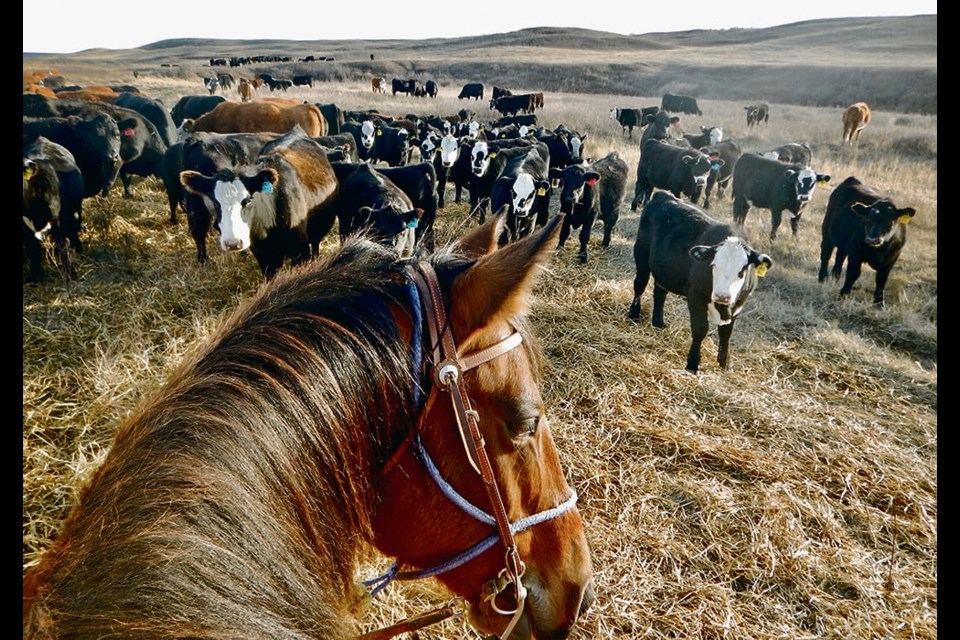HERBERT, Sask. — Applications for the latest livestock program assistance program are open in Saskatchewan but some cattle producers are less than enthused about this version of AgriRecovery.
They’d prefer something like the 2021 drought recovery program that paid $200 per head to all producers.
The 2023 program is targeted to certain areas and pays $150 per head initially to cover up to 70 percent of extraordinary costs for feed and freight from May 1, 2023 to March 31, 2024.
The program terms and conditions state payments are based on a $285 maximum, which would be $200 at 70 percent. Producers attending a Saskatchewan Cattlemen’s Association district meeting questioned why they are getting less.
Chief executive officer Grant McLellan explained it likely has to do with the 60:40 federal-provincial cost-share.
In August, the province announced it would spend $70 million to help drought-affected producers.
“If you reverse engineer the math on that it works out to $80 a head, which is their 40 percent of a $200-per-head payment,” he said. “The federal government… announced $77 million (for Saskatchewan), which is not the same as $110 million approximately to get you to that $200 a head.”
He said SCA would continue to lobby Ottawa to step up with more.
The Canada-Saskatchewan Feed Program eligibility requirements are based on a map developed by the federal government and the Canadian Drought Monitor.
Producers must have lost at least 25 feed days and require receipts for eligible expenses. Those include the cost of purchased feed, transportation including self-hauling and renting land for additional grazing or feed production.
“Temporary fencing and anything to do with water do not qualify,” said Jodie Griffin from Saskatchewan Crop Insurance Corp. during the meeting.
“It’s anything you had to do over and above what you did in 2022 or what you’ve done in the last five years and it all has to be associated to feed and transport.”
Cutting ditches and sloughs doesn’t qualify, she said.
Brock Gillanders, who raises cattle in the Rural Municipality of Lacadena, said his region has been hard hit by drought the last three years.
“We will not be eligible for that because we spent all summer in a ditch or a slough or someplace else,” he said.
He and others worked hard to secure feed on their own but won’t have receipts to provide.
“I think this program is not going to help very many people in the most drought affected areas,” he said, adding he would have preferred a lower payment go to more producers.
Producers who fall outside the map boundaries may be eligible for a provincial payment of $60 initially and a maximum $70 per head but none of the federal money.
Producer Dave Marzolf said the government is telling producers to sell their calves and shut down the industry.
“It doesn’t appear as though they really care about bringing any more people into the industry,” he said.
“I don’t think that honestly there’s been an honest effort put into how important this industry is to this province with the government of Canada and it’s frustrating to listen that it’s got to be justified by a map.”
He predicted a lot of herds will be gone in 2024.
The 2023 program does include bulls, which were excluded in 2021, and allows a herd ratio of 1:20. Horses are also included this time, at an equivalent animal unit to beef cattle.
“This program is all about maintaining that breeding herd,” Griffin said.
It also includes bison, elk, deer, sheep and goats. The initial payments will be adjusted by species.
Applications and more information are available on the SCIC website.
Alberta also opened applications for its livestock feed assistance program Oct. 30.
Producers who altered grazing practises for more than three weeks this year due to drought conditions will be eligible for the program.
Up to $150 per head will be made available to livestock producers based on a feed-need calculation for lost grazing days for breeding animals on hand as of Dec. 31.
The funding is part of a joint federal-provincial package offered through AgriRecovery, which will see the Alberta government chip in $66 million and Ottawa $99 million to assist ranchers with extra-ordinary costs associated with accessing feed.
Applications will be made available through the Agriculture Financial Services Corp.
Eligible livestock includes cattle, horses, sheep and other domesticated grazing animals.
The application deadline is Jan. 15, 2024, with the program covering costs incurred until the end of March.




